Professional Identity: Reflection on Clinical Experience Essay
VerifiedAdded on 2020/03/23
|7
|1266
|206
Essay
AI Summary
This essay presents a reflective analysis of a nursing student's clinical experience, focusing on the application of nursing standards of practice. The student uses Tanner's clinical judgment model to examine an incident involving a 23-year-old male patient admitted with severe depression and a history of self-harm. The essay details the challenges faced in building rapport with the patient, who is from an Aboriginal community, and his family, highlighting the impact of cultural stigma on mental health treatment. The student reflects on the application of critical thinking and therapeutic relationships, referencing the Nursing and Midwifery Board of Australia standards. The reflection also includes a critical evaluation of the student's actions, particularly regarding the failure to report inappropriate behavior of other healthcare staff, and concludes with insights gained about the responsibilities of a registered nurse and the importance of continuous professional development.
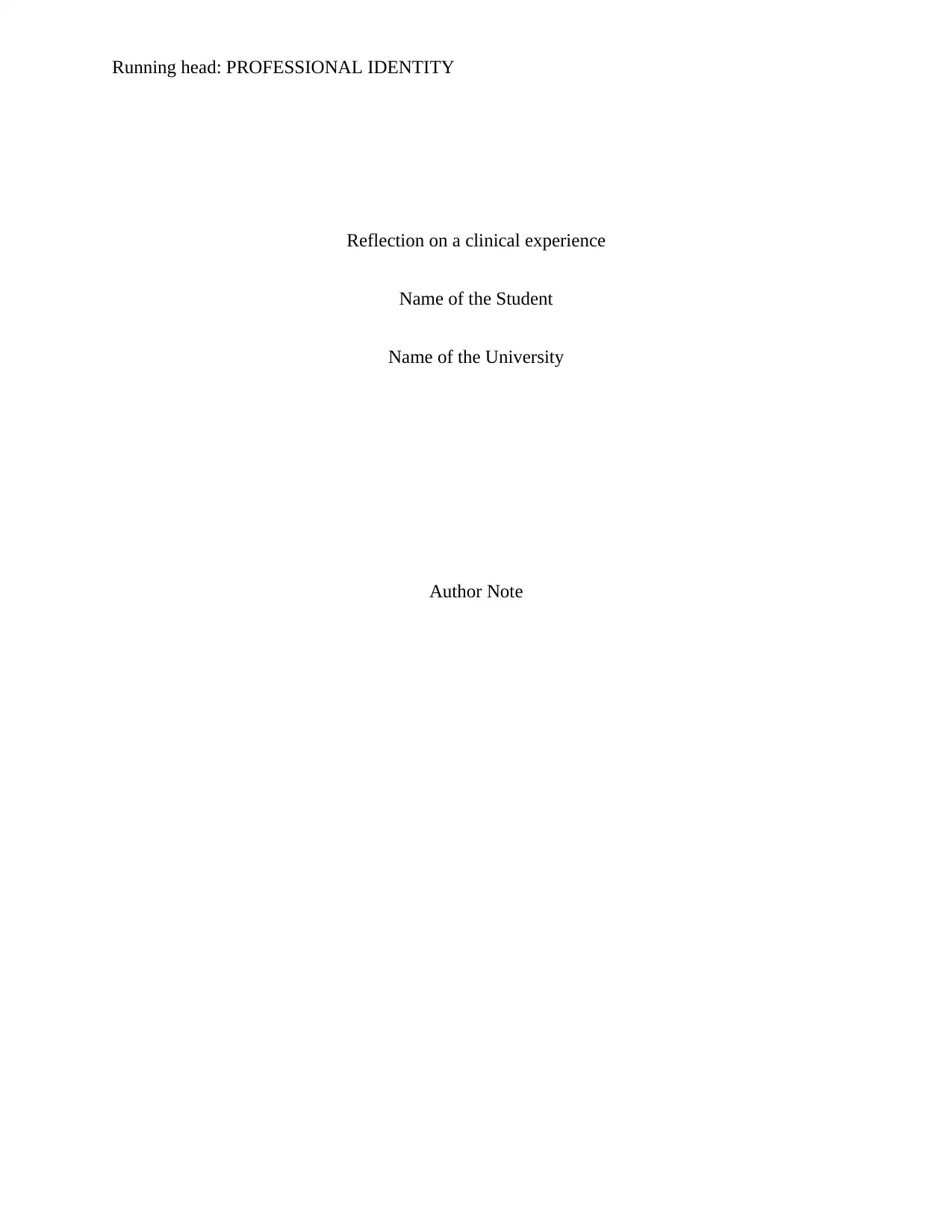
Running head: PROFESSIONAL IDENTITY
Reflection on a clinical experience
Name of the Student
Name of the University
Author Note
Reflection on a clinical experience
Name of the Student
Name of the University
Author Note
Paraphrase This Document
Need a fresh take? Get an instant paraphrase of this document with our AI Paraphraser
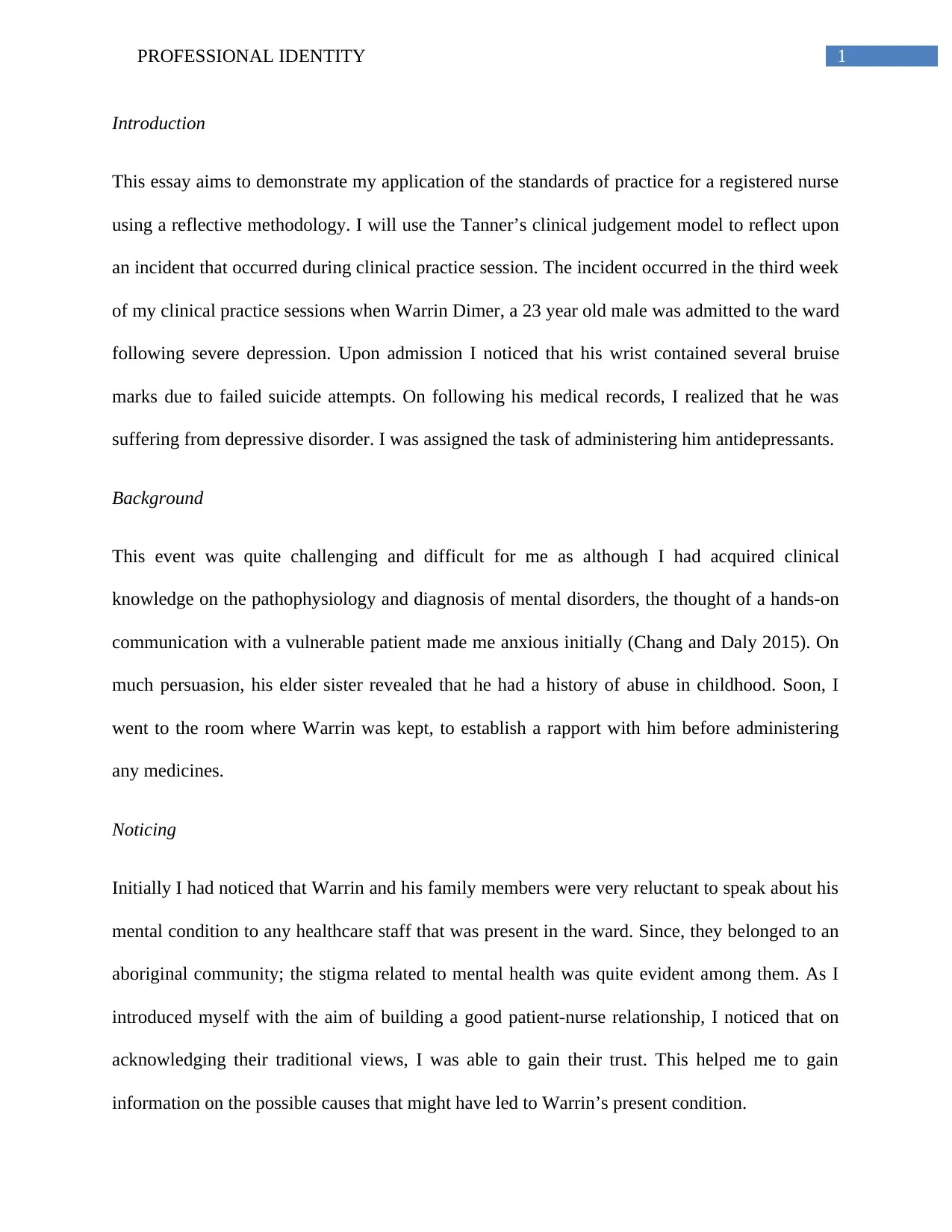
1PROFESSIONAL IDENTITY
Introduction
This essay aims to demonstrate my application of the standards of practice for a registered nurse
using a reflective methodology. I will use the Tanner’s clinical judgement model to reflect upon
an incident that occurred during clinical practice session. The incident occurred in the third week
of my clinical practice sessions when Warrin Dimer, a 23 year old male was admitted to the ward
following severe depression. Upon admission I noticed that his wrist contained several bruise
marks due to failed suicide attempts. On following his medical records, I realized that he was
suffering from depressive disorder. I was assigned the task of administering him antidepressants.
Background
This event was quite challenging and difficult for me as although I had acquired clinical
knowledge on the pathophysiology and diagnosis of mental disorders, the thought of a hands-on
communication with a vulnerable patient made me anxious initially (Chang and Daly 2015). On
much persuasion, his elder sister revealed that he had a history of abuse in childhood. Soon, I
went to the room where Warrin was kept, to establish a rapport with him before administering
any medicines.
Noticing
Initially I had noticed that Warrin and his family members were very reluctant to speak about his
mental condition to any healthcare staff that was present in the ward. Since, they belonged to an
aboriginal community; the stigma related to mental health was quite evident among them. As I
introduced myself with the aim of building a good patient-nurse relationship, I noticed that on
acknowledging their traditional views, I was able to gain their trust. This helped me to gain
information on the possible causes that might have led to Warrin’s present condition.
Introduction
This essay aims to demonstrate my application of the standards of practice for a registered nurse
using a reflective methodology. I will use the Tanner’s clinical judgement model to reflect upon
an incident that occurred during clinical practice session. The incident occurred in the third week
of my clinical practice sessions when Warrin Dimer, a 23 year old male was admitted to the ward
following severe depression. Upon admission I noticed that his wrist contained several bruise
marks due to failed suicide attempts. On following his medical records, I realized that he was
suffering from depressive disorder. I was assigned the task of administering him antidepressants.
Background
This event was quite challenging and difficult for me as although I had acquired clinical
knowledge on the pathophysiology and diagnosis of mental disorders, the thought of a hands-on
communication with a vulnerable patient made me anxious initially (Chang and Daly 2015). On
much persuasion, his elder sister revealed that he had a history of abuse in childhood. Soon, I
went to the room where Warrin was kept, to establish a rapport with him before administering
any medicines.
Noticing
Initially I had noticed that Warrin and his family members were very reluctant to speak about his
mental condition to any healthcare staff that was present in the ward. Since, they belonged to an
aboriginal community; the stigma related to mental health was quite evident among them. As I
introduced myself with the aim of building a good patient-nurse relationship, I noticed that on
acknowledging their traditional views, I was able to gain their trust. This helped me to gain
information on the possible causes that might have led to Warrin’s present condition.
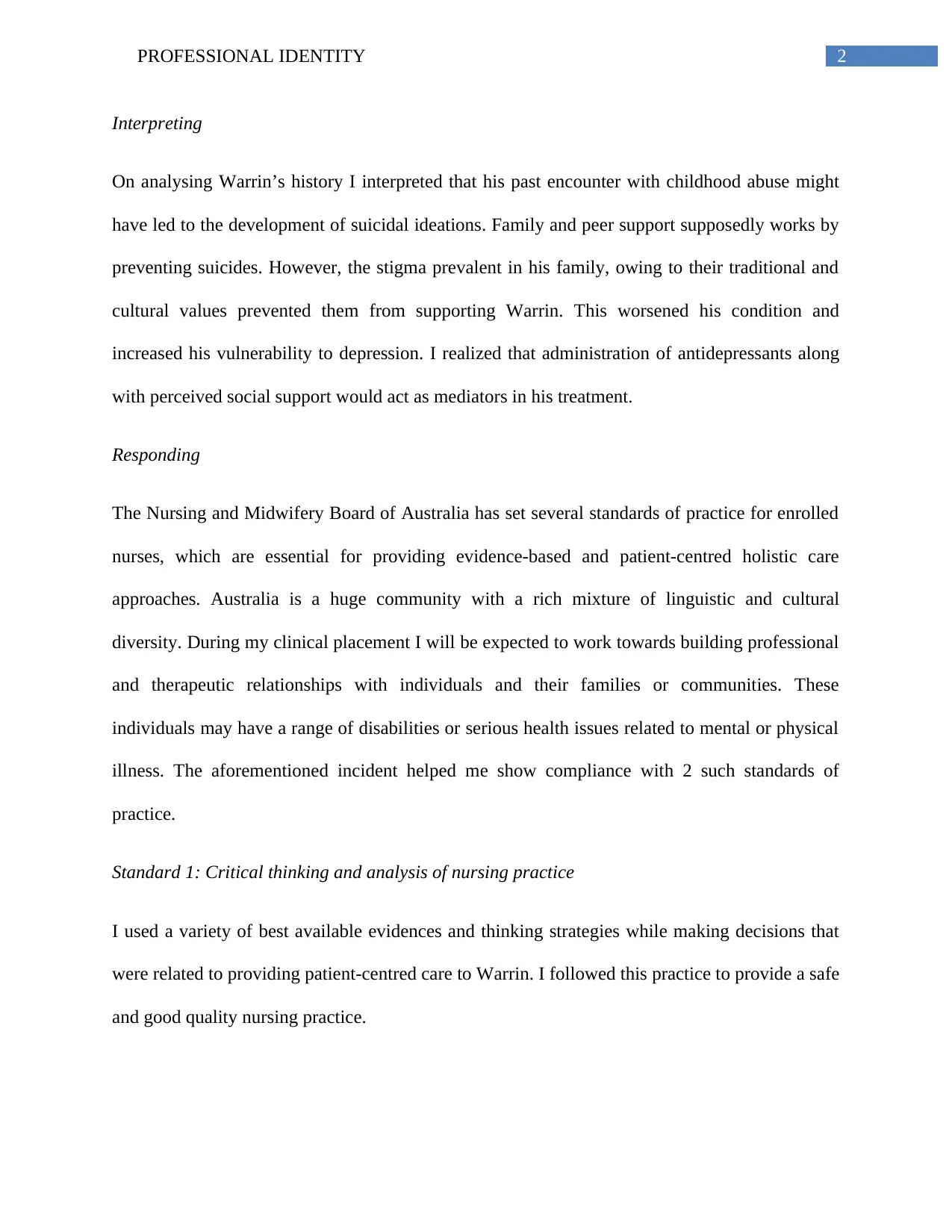
2PROFESSIONAL IDENTITY
Interpreting
On analysing Warrin’s history I interpreted that his past encounter with childhood abuse might
have led to the development of suicidal ideations. Family and peer support supposedly works by
preventing suicides. However, the stigma prevalent in his family, owing to their traditional and
cultural values prevented them from supporting Warrin. This worsened his condition and
increased his vulnerability to depression. I realized that administration of antidepressants along
with perceived social support would act as mediators in his treatment.
Responding
The Nursing and Midwifery Board of Australia has set several standards of practice for enrolled
nurses, which are essential for providing evidence-based and patient-centred holistic care
approaches. Australia is a huge community with a rich mixture of linguistic and cultural
diversity. During my clinical placement I will be expected to work towards building professional
and therapeutic relationships with individuals and their families or communities. These
individuals may have a range of disabilities or serious health issues related to mental or physical
illness. The aforementioned incident helped me show compliance with 2 such standards of
practice.
Standard 1: Critical thinking and analysis of nursing practice
I used a variety of best available evidences and thinking strategies while making decisions that
were related to providing patient-centred care to Warrin. I followed this practice to provide a safe
and good quality nursing practice.
Interpreting
On analysing Warrin’s history I interpreted that his past encounter with childhood abuse might
have led to the development of suicidal ideations. Family and peer support supposedly works by
preventing suicides. However, the stigma prevalent in his family, owing to their traditional and
cultural values prevented them from supporting Warrin. This worsened his condition and
increased his vulnerability to depression. I realized that administration of antidepressants along
with perceived social support would act as mediators in his treatment.
Responding
The Nursing and Midwifery Board of Australia has set several standards of practice for enrolled
nurses, which are essential for providing evidence-based and patient-centred holistic care
approaches. Australia is a huge community with a rich mixture of linguistic and cultural
diversity. During my clinical placement I will be expected to work towards building professional
and therapeutic relationships with individuals and their families or communities. These
individuals may have a range of disabilities or serious health issues related to mental or physical
illness. The aforementioned incident helped me show compliance with 2 such standards of
practice.
Standard 1: Critical thinking and analysis of nursing practice
I used a variety of best available evidences and thinking strategies while making decisions that
were related to providing patient-centred care to Warrin. I followed this practice to provide a safe
and good quality nursing practice.
⊘ This is a preview!⊘
Do you want full access?
Subscribe today to unlock all pages.

Trusted by 1+ million students worldwide
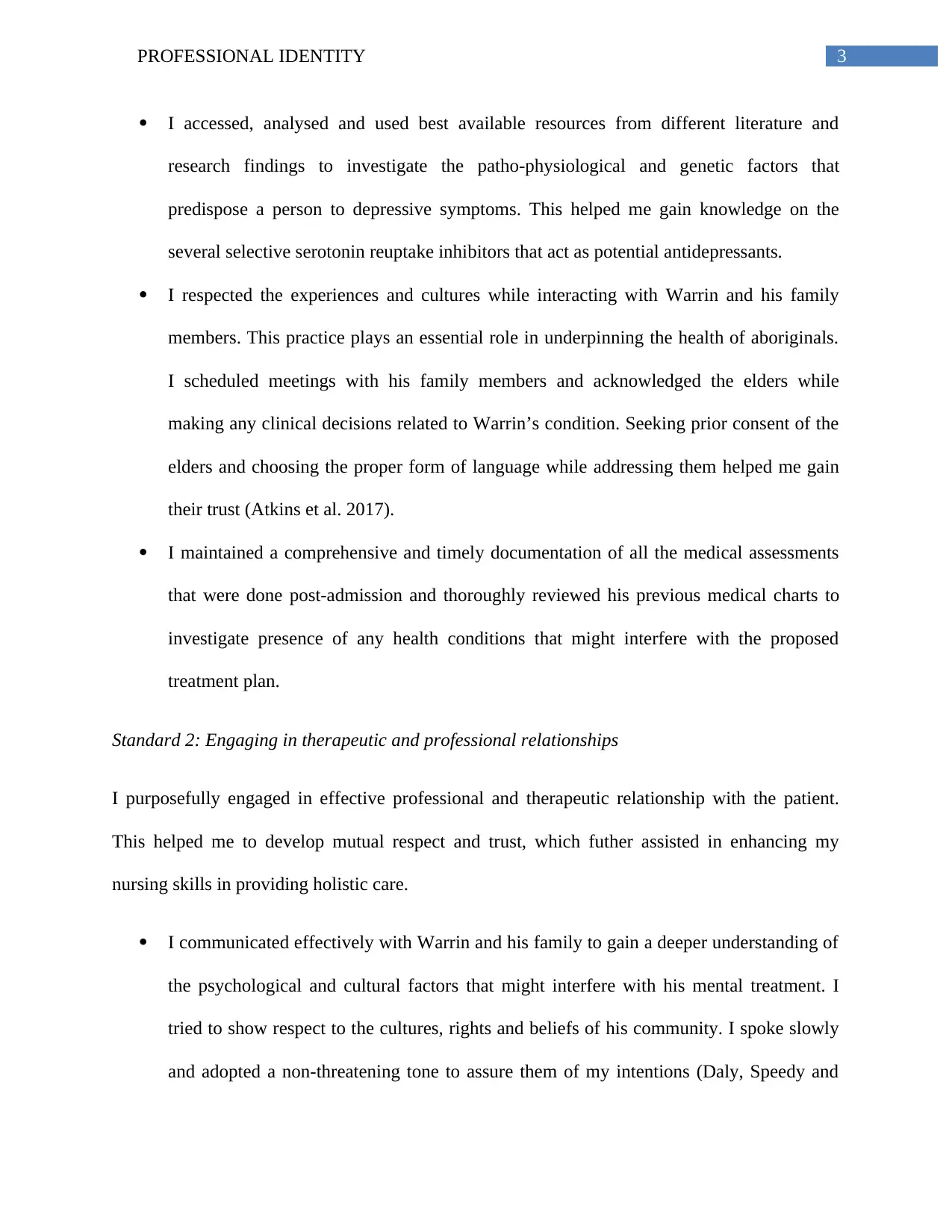
3PROFESSIONAL IDENTITY
I accessed, analysed and used best available resources from different literature and
research findings to investigate the patho-physiological and genetic factors that
predispose a person to depressive symptoms. This helped me gain knowledge on the
several selective serotonin reuptake inhibitors that act as potential antidepressants.
I respected the experiences and cultures while interacting with Warrin and his family
members. This practice plays an essential role in underpinning the health of aboriginals.
I scheduled meetings with his family members and acknowledged the elders while
making any clinical decisions related to Warrin’s condition. Seeking prior consent of the
elders and choosing the proper form of language while addressing them helped me gain
their trust (Atkins et al. 2017).
I maintained a comprehensive and timely documentation of all the medical assessments
that were done post-admission and thoroughly reviewed his previous medical charts to
investigate presence of any health conditions that might interfere with the proposed
treatment plan.
Standard 2: Engaging in therapeutic and professional relationships
I purposefully engaged in effective professional and therapeutic relationship with the patient.
This helped me to develop mutual respect and trust, which futher assisted in enhancing my
nursing skills in providing holistic care.
I communicated effectively with Warrin and his family to gain a deeper understanding of
the psychological and cultural factors that might interfere with his mental treatment. I
tried to show respect to the cultures, rights and beliefs of his community. I spoke slowly
and adopted a non-threatening tone to assure them of my intentions (Daly, Speedy and
I accessed, analysed and used best available resources from different literature and
research findings to investigate the patho-physiological and genetic factors that
predispose a person to depressive symptoms. This helped me gain knowledge on the
several selective serotonin reuptake inhibitors that act as potential antidepressants.
I respected the experiences and cultures while interacting with Warrin and his family
members. This practice plays an essential role in underpinning the health of aboriginals.
I scheduled meetings with his family members and acknowledged the elders while
making any clinical decisions related to Warrin’s condition. Seeking prior consent of the
elders and choosing the proper form of language while addressing them helped me gain
their trust (Atkins et al. 2017).
I maintained a comprehensive and timely documentation of all the medical assessments
that were done post-admission and thoroughly reviewed his previous medical charts to
investigate presence of any health conditions that might interfere with the proposed
treatment plan.
Standard 2: Engaging in therapeutic and professional relationships
I purposefully engaged in effective professional and therapeutic relationship with the patient.
This helped me to develop mutual respect and trust, which futher assisted in enhancing my
nursing skills in providing holistic care.
I communicated effectively with Warrin and his family to gain a deeper understanding of
the psychological and cultural factors that might interfere with his mental treatment. I
tried to show respect to the cultures, rights and beliefs of his community. I spoke slowly
and adopted a non-threatening tone to assure them of my intentions (Daly, Speedy and
Paraphrase This Document
Need a fresh take? Get an instant paraphrase of this document with our AI Paraphraser
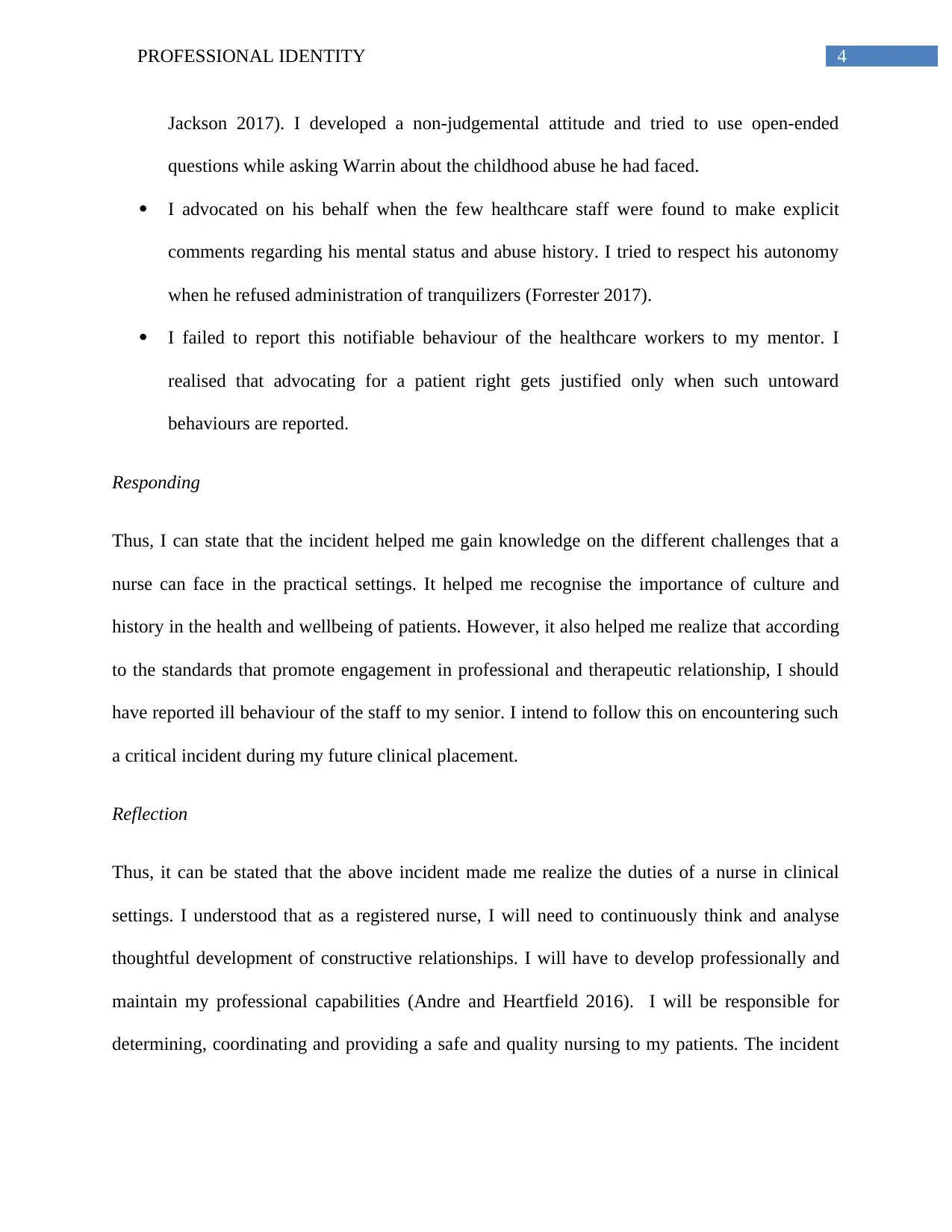
4PROFESSIONAL IDENTITY
Jackson 2017). I developed a non-judgemental attitude and tried to use open-ended
questions while asking Warrin about the childhood abuse he had faced.
I advocated on his behalf when the few healthcare staff were found to make explicit
comments regarding his mental status and abuse history. I tried to respect his autonomy
when he refused administration of tranquilizers (Forrester 2017).
I failed to report this notifiable behaviour of the healthcare workers to my mentor. I
realised that advocating for a patient right gets justified only when such untoward
behaviours are reported.
Responding
Thus, I can state that the incident helped me gain knowledge on the different challenges that a
nurse can face in the practical settings. It helped me recognise the importance of culture and
history in the health and wellbeing of patients. However, it also helped me realize that according
to the standards that promote engagement in professional and therapeutic relationship, I should
have reported ill behaviour of the staff to my senior. I intend to follow this on encountering such
a critical incident during my future clinical placement.
Reflection
Thus, it can be stated that the above incident made me realize the duties of a nurse in clinical
settings. I understood that as a registered nurse, I will need to continuously think and analyse
thoughtful development of constructive relationships. I will have to develop professionally and
maintain my professional capabilities (Andre and Heartfield 2016). I will be responsible for
determining, coordinating and providing a safe and quality nursing to my patients. The incident
Jackson 2017). I developed a non-judgemental attitude and tried to use open-ended
questions while asking Warrin about the childhood abuse he had faced.
I advocated on his behalf when the few healthcare staff were found to make explicit
comments regarding his mental status and abuse history. I tried to respect his autonomy
when he refused administration of tranquilizers (Forrester 2017).
I failed to report this notifiable behaviour of the healthcare workers to my mentor. I
realised that advocating for a patient right gets justified only when such untoward
behaviours are reported.
Responding
Thus, I can state that the incident helped me gain knowledge on the different challenges that a
nurse can face in the practical settings. It helped me recognise the importance of culture and
history in the health and wellbeing of patients. However, it also helped me realize that according
to the standards that promote engagement in professional and therapeutic relationship, I should
have reported ill behaviour of the staff to my senior. I intend to follow this on encountering such
a critical incident during my future clinical placement.
Reflection
Thus, it can be stated that the above incident made me realize the duties of a nurse in clinical
settings. I understood that as a registered nurse, I will need to continuously think and analyse
thoughtful development of constructive relationships. I will have to develop professionally and
maintain my professional capabilities (Andre and Heartfield 2016). I will be responsible for
determining, coordinating and providing a safe and quality nursing to my patients. The incident
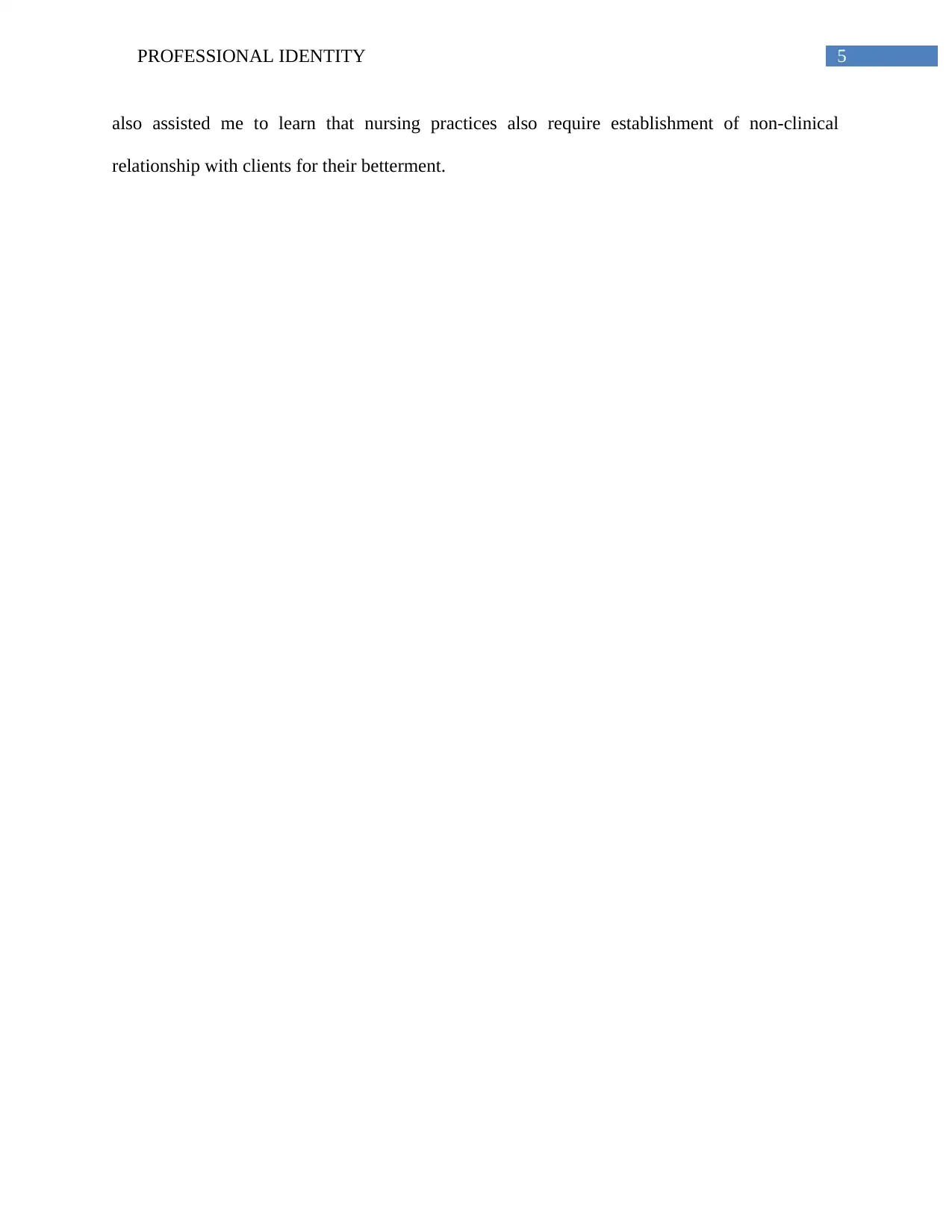
5PROFESSIONAL IDENTITY
also assisted me to learn that nursing practices also require establishment of non-clinical
relationship with clients for their betterment.
also assisted me to learn that nursing practices also require establishment of non-clinical
relationship with clients for their betterment.
⊘ This is a preview!⊘
Do you want full access?
Subscribe today to unlock all pages.

Trusted by 1+ million students worldwide
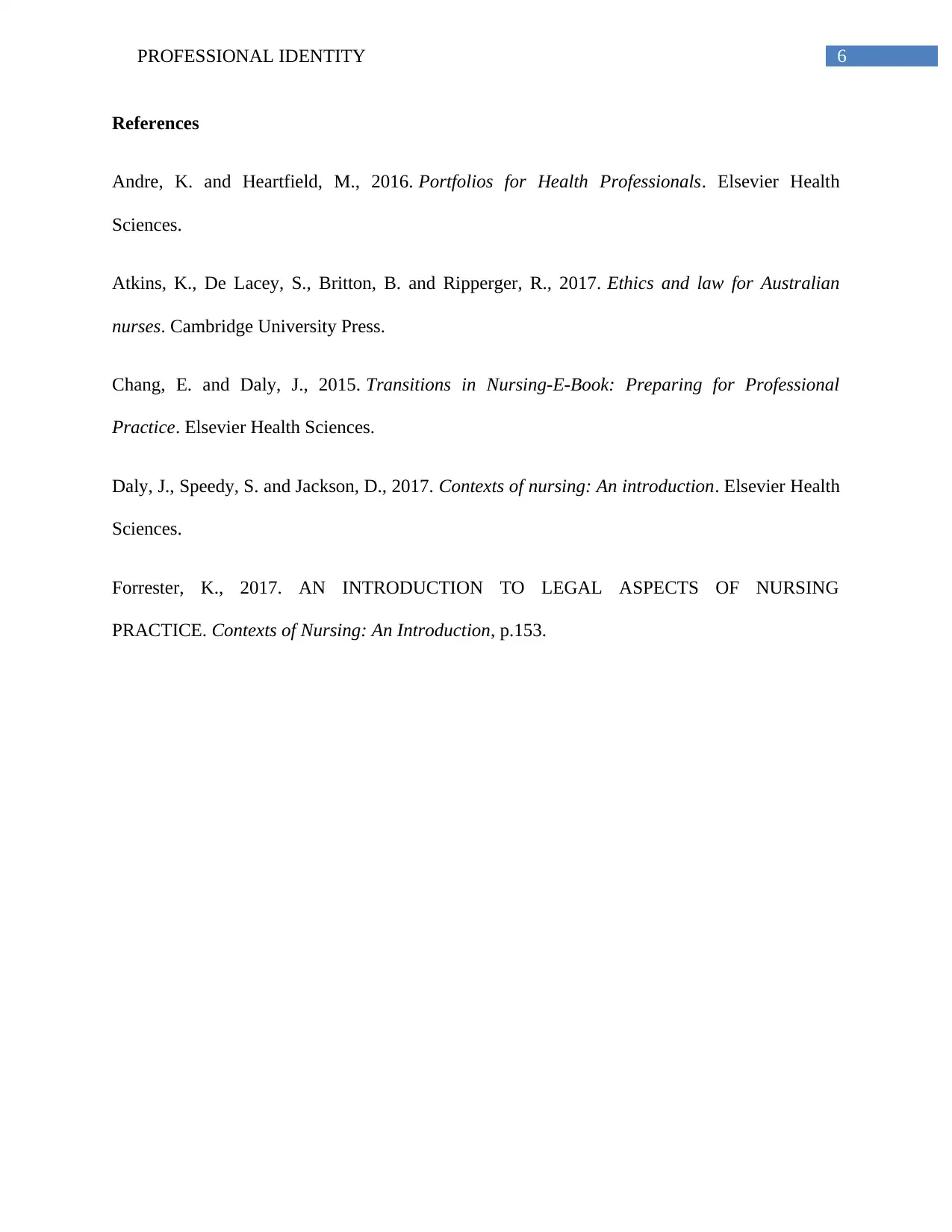
6PROFESSIONAL IDENTITY
References
Andre, K. and Heartfield, M., 2016. Portfolios for Health Professionals. Elsevier Health
Sciences.
Atkins, K., De Lacey, S., Britton, B. and Ripperger, R., 2017. Ethics and law for Australian
nurses. Cambridge University Press.
Chang, E. and Daly, J., 2015. Transitions in Nursing-E-Book: Preparing for Professional
Practice. Elsevier Health Sciences.
Daly, J., Speedy, S. and Jackson, D., 2017. Contexts of nursing: An introduction. Elsevier Health
Sciences.
Forrester, K., 2017. AN INTRODUCTION TO LEGAL ASPECTS OF NURSING
PRACTICE. Contexts of Nursing: An Introduction, p.153.
References
Andre, K. and Heartfield, M., 2016. Portfolios for Health Professionals. Elsevier Health
Sciences.
Atkins, K., De Lacey, S., Britton, B. and Ripperger, R., 2017. Ethics and law for Australian
nurses. Cambridge University Press.
Chang, E. and Daly, J., 2015. Transitions in Nursing-E-Book: Preparing for Professional
Practice. Elsevier Health Sciences.
Daly, J., Speedy, S. and Jackson, D., 2017. Contexts of nursing: An introduction. Elsevier Health
Sciences.
Forrester, K., 2017. AN INTRODUCTION TO LEGAL ASPECTS OF NURSING
PRACTICE. Contexts of Nursing: An Introduction, p.153.
1 out of 7
Related Documents
Your All-in-One AI-Powered Toolkit for Academic Success.
+13062052269
info@desklib.com
Available 24*7 on WhatsApp / Email
![[object Object]](/_next/static/media/star-bottom.7253800d.svg)
Unlock your academic potential
Copyright © 2020–2025 A2Z Services. All Rights Reserved. Developed and managed by ZUCOL.





